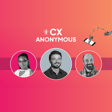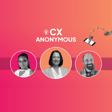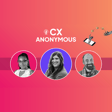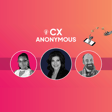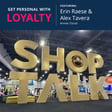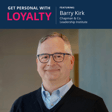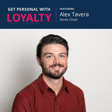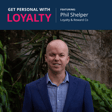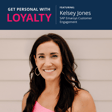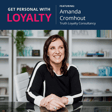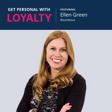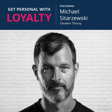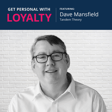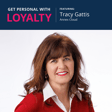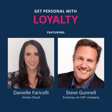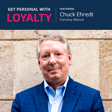Become a Creator today!Start creating today - Share your story with the world!
Start for free
00:00:00
00:00:01

Loyalty Lessons: Launching Loyalty Campaigns
In this episode of CX Anonymous, we welcome Jake Madrigal, a Customer Success leader with a proven track record of launching successful loyalty programs. Jake dives deep into the strategic planning, risk management, and impactful execution that goes into crafting loyalty campaigns that truly resonate with customers across all touchpoints. Listen for some excellent examples of loyalty campaigns that might work for you!
Transcript
Introduction to CX Anonymous and Guests
00:00:08
Speaker
Hey, everybody. Welcome to CX Anonymous, the series where we provide tactical advice on successfully executing customer experience. We don't care who you work for, just how it got done. I'm your host, Amber Collins, Product Marketing Manager with Scott Sherson, Product Solutions Director and a host of guests for our second season. Today, we're joined by Jake Magigal, Head of Customer Success here at Annex Cloud. Welcome, Jake. We're so happy to have you.
Role of Customer Success at Annex Cloud
00:00:36
Speaker
Why don't you tell us a little bit about your role and where you get involved with the clients and then. Yeah. So right now I'm the head of customer success at annex cloud. I've been working within the loyalty space and for annex cloud specifically.
00:00:50
Speaker
12 years now. So I've been around for a while and I've been here to help a number of our clients get up and running with their loyalty program as well as help provide best practices and strategy to get the most out of their loyalty program. So the customer success team is really kind of there holding the hand of the client once they go live to really get the most of their experience with AnnexCOD and their loyalty program itself.
00:01:15
Speaker
Yeah, I mean so essentially you are in the thick of loyalty program and campaign and helping our customers take advantage of our innovations and I've heard you called a strategic arm for our clients and just.
00:01:30
Speaker
the experience that you bring back to my team and marketing, I'm constantly impressed with the knowledge that you bring.
Exploring the Loyalty Lounge Platform
00:01:36
Speaker
Some people may recognize you as participating in our virtual loyalty lounges, our monthly theories that we've started that are just a very intimate conversation about loyalty and what we're seeing in the marketplace and what's working for our clients. I believe that Scott can agree that your role is extremely important,
00:01:56
Speaker
to help our clients mitigate risk and turn and execute loyalty to the best of the industry, to be innovative, to take advantage of our technology. That's great. I think the Loyalty Lounge has been a great addition for our clients, just a safe space to talk about what they're seeing with their program, maybe looking for different recommendations. If you haven't checked out the Loyalty Lounge, I definitely advise you to take part of that the next time we have that.
00:02:22
Speaker
I love having those. So today I would love to dive into some lessons you've learned having supported so many programs.
Q&A: Marketing vs. Loyalty Campaigns
00:02:29
Speaker
I'm talking across industries. I'm talking across types, member types, countries, regions, just brands. I know you've done it all. So let's jump in. I would love to start by differentiating when we say a marketing campaign and a loyalty campaign. And how do you define that? And how do you coach your clients through knowing the difference between the two?
00:02:53
Speaker
Yeah, I think for our clients specifically, what we talk about when a client is preparing for the launch of a program is some of those core marketing emails or marketing campaigns that you should have as part of your everyday strategy. So those would be things like a welcome email for the program when you join the program, when you enroll in the program. I mean, to start an announcement email for the program, kind of going through
00:03:18
Speaker
What is this program offer what are the benefits to a customer and then some of the other common recurring i guess you could say triggered emails that should be set up as part of these loyalty programs are things like a monthly point statement that kind of gives an overview of what you're at maybe how much you need to spend or how many points you need to earn to get to the next year as well as some recommendations of how you can engage.
00:03:44
Speaker
with the program. So some of these things like welcome emails, monthly, you know, statement emails.
00:03:50
Speaker
announcement emails for the program or even something like an expiration email telling you how many points you have for expiration. Those are some of the core marketing campaign emails, I guess you could say, as part of the program.
Boosting Sales with Loyalty Campaigns
00:04:03
Speaker
Loyalty campaigns, those are utilizing the program, utilizing the software and the solutions that we provide around segmentation and campaign functionality to drive a specific goal.
00:04:17
Speaker
So let's say, for example, a client's kind of in a slow period, and they want to increase sales or increase conversion or just increase engagement of their audience during that timeframe. That's where you would utilize a loyalty campaign. And that might be something like a double point or a triple point event for that example, right? And those campaigns can be much more in depth, can be much more segmented from that perspective. But just in general, when it comes to thinking,
00:04:45
Speaker
standard marketing emails, marketing campaigns for loyalty, or kind of a focused loyalty campaign on maybe a segment or a core group of products. That's a little bit of the difference between those two, if that makes sense. That makes a lot of sense. When I'm usually talking with people like in pre-sales and like, what is the difference and why do we need a loyalty platform? A lot of times I'm getting marketers who are new to loyalty as well. And they, I'm,
00:05:13
Speaker
taking them out of kind of a head space of marketing communication. So a lot of things that you're talking about that have like, um, get to know, you know, more about the program, get to know about this, but marketing campaigns that I see are typically focused around time of day, day of week, individualized conversations, maybe playing with some verbiage or some like the title of a communication stuff like that. So I look at marketing conversations.
00:05:43
Speaker
as just tell me about the brand. Tell me like who you are versus loyalty. As you very succinctly said, I'm trying to change a behavior. I'm trying to change a loyalty behavior. People I know are more likely to change the behaviors because they've signed up for because they are my most loyal customer. So I differentiate in between those two.
Integrating Loyalty Strategies Across Touchpoints
00:06:03
Speaker
Do you see that you have a lot of those conversations or
00:06:06
Speaker
When they come to you, they already have made that distinction between the two and you can just really focus on behavioral. Yeah, I think once they've gone live, right, they've done a lot of that core work up front during the implementation of planning the kind of ongoing communication strategy, right?
00:06:23
Speaker
So once a client has gone live once their programs in production as we call it and is out there for the audience to see that's where the focus becomes much more targeted on what types of behaviors can we influence what types of goals can we drive with loyalty right and that's where it becomes much more focused on as we call it refer to it the loyalty campaign strategy where you can get very deep into
00:06:47
Speaker
very segmented and specific audiences that you're trying to drive a specific behavior trying to influence a specific goal with that loyalty campaign. A lot of the customers trying to do like a breadcrumb of loyalty within most of their communications where they're always putting your point balance in it even if they're just telling you about a new product line or something like that just to kind of keep referring.
00:07:12
Speaker
Or do we not see that? Would you prefer that they did do that to kind of like keep loyalty top of mind? How do you take a look at those?
00:07:20
Speaker
Yeah, I think from daily communication, that's the bread and butter is we really advise clients to overexpose loyalty from that perspective. When a customer is opening a normal email communication and just might be, hey, we have a sale or we have a new product, whatever that may be, and the header, like you're mentioning, Scott, and the header of that email reinforcing
00:07:43
Speaker
These are how many points you have. This is what tier you're in. Maybe this is how many dollars, if you're offering discounts within your program, if you're offering a kind of point to currency conversion, how many dollars your points are worth. Put that front and center in that program or in that marketing email so they can always see where they're at with loyalty, even if the core message of that email isn't focused directly around loyalty.
00:08:09
Speaker
So I think that's some of that bread and butter that we talk about upfront during the implementation is these are the best practices that you should evaluate now so that once we go live, we're really working on kind of how do we move the needle?
Enhancing Engagement through Over-Exposure
00:08:24
Speaker
How do we change that behavior? How do we influence that behavior? But of course, yeah, overexposure across the board, whether that's in your email communication, whether that's just when a customer logs into their accounts and in the header of the site, they can see
00:08:39
Speaker
how many points i have what year i met how much i need to get to get to the next year what those benefits might be for me because i'm in the higher tier i think those are all very important call to actions to have kind of across the communication experience. Yeah really reflects a culture of loyalty rather than an initiative of loyalty totally yeah i think the worst thing in the program is when.
00:09:03
Speaker
You don't know where you're at. You don't know how many points you have. You're getting marketing emails and saying, hey, come buy this product. I'm part of this program. I have no idea where I'm at. I don't know how many points have. I don't know what those points mean in terms of what the reward value is. Right. So I think what you're referring to is having that communication, having that exposure to the program.
00:09:24
Speaker
whether it's in emails, in SMS communication, even onsite during that customer experience of shopping. Absolutely. Very important, right? I think one of the biggest things we see as a best practice is at the cart. So when you're getting to the cart through your shopping experience, being able to see how many points is this purchase going to get me? And what are those points amount to? And if I have points,
00:09:49
Speaker
I want to be able to easily apply them at checkout at the cart right and do that conversion right there so I can apply my discount quick and easily. So just over communication of your status within the program whether that's an email and text and kind of just your browsing experience are all very key to the success of the program. All right so once you've got that
00:10:14
Speaker
let's call it integrated or omni-channel loyalty strategy in all of those customer touch points. That is honestly like, like you said, bread and butter or table steaks are just like, this is the customer journey. And we've identified all of the opportunities to insert loyalty into these touch points and communications, including empowering your frontline sales associates and integrating to the POS, which we hope all of our clients have done through the implementation.
Creating Impactful Loyalty Campaigns
00:10:42
Speaker
Now you're ready to build on those tentpole campaigns or even annual campaigns. I know that we've talked about a few examples of annual campaigns, but all of those things that start to go into surprise and delight and create a sense of urgency and scarcity and really go above and beyond just, oh, you're here now. Then we say, look at this shiny object that we got for you, specifically for you because we're all about personalization.
00:11:09
Speaker
So when we're planning these new tentpole campaigns and these new annual campaigns that are pure loyalty plays which of course is never just loyalty because it includes a lot of other stakeholders to get these things off the ground. What questions should those program managers ask themselves and in turn ask the rest of their organization?
00:11:28
Speaker
And what should they be asking you when they're thinking about doing these above the customer journey type of loyalty campaign? I think the biggest thing to ask yourself as a marketer or your team that you're working with on the program is what are we trying to influence with this campaign? What is the goal of this campaign? Right. Sometimes clients come to us and they're like, hey, we want to run campaigns.
00:11:50
Speaker
And we can do a lot of different types of campaigns with the segmentation and campaign functionality that we support. But the question back to the client is, what are we trying to drive with this campaign? What KPI are we trying to influence? What goal are we trying to drive?
00:12:07
Speaker
Sometimes, for example, clients will come to us and they'll say, hey, we want a campaign that's going to drive purchases. We go, okay, we can set up a campaign that'll be focused on purchases, but what specifically are we trying to drive? Are we trying to drive specific products? Are we trying to drive a category or a specific brand that you sell as a retailer? What is it that we're trying to influence here? We ask those questions to get deeper into the goal of this potential campaign.
Case Study: Loyalty Driving Reviews
00:12:34
Speaker
At the end of the day, the conversation might lead to, hey,
00:12:38
Speaker
We have a lot of products from last year. Last year's product release that we want to push out the door, but we'd love to try and push those at the door without putting them on sale, right? So that's a perfect example of we want to drive orders. We want to drive sales.
00:12:54
Speaker
What type of sales? What type of orders do you want to drive? We want to drive this product line from last year to clear inventory, but we don't want to put it on sale. We want to try and use loyalty to influence that behavior. That's where the CSM team, the customer success team here at NX Cloud, will start thinking about what types of campaigns and segments support that. In this example, specifically, I would tell the client, okay, well, let's run a bonus point campaign or a point multiplier campaign.
00:13:23
Speaker
only on that specific segment of products. So you identify which product should be part of the Point Multiplier, part of the Bonus Campaign. You provide that product information to NX Cloud. NX Cloud will create and build a segment of those products.
00:13:39
Speaker
and then we'll tie that segment to a specific campaign that says, hey, if anyone purchases during this weekend and they purchase one of these products or multiple of these products, you're going to earn triple the amount of points, or you're going to earn 500 bonus points from that example.
00:13:56
Speaker
And if you want to take it a step further, you can even say, hey, we want them to purchase this set of products or one of these products, but we want them to spend over $300 before they get a bonus. So now you can even customize that segment further and say, if they purchase one of these products,
00:14:13
Speaker
but if they also spend over an order value of $300, then give them this bonus or then give them triple points on those specific products. We want to understand the goals. We want to understand what are we trying to achieve with this campaign and then get as specific as possible to hit that goal and to reach that goal. That's just one example of how we might have that conversation with a client.
00:14:37
Speaker
There's an example of a client that I do believe came from you or team. As a marketer who is in product, so I'm close to sales, we could say all day that the biggest KPI is sales, sales, sales, sales. But the thing that I love about loyalty and the way that we can influence behavior is the story that I was told about the client that
00:15:00
Speaker
Wanted to garner reviews and ratings fast on new products because that built the credibility and the authority of that product and they use loyalty to reward the super reviewers and therefore that new product looked so lived in.
00:15:16
Speaker
on their website and when you went and shopped on Google for them. It just stood that product up so quickly by a group of trusted customers. That as a KPI to build trust in the marketplace through reviews and ratings is a KPI that I love that we can affect with loyalty. I know, Scott, you've got some other ways that we can influence action with loyalty.
00:15:44
Speaker
I do, but really my question for Jake is we know that somebody coming to a company like ours, they're moving beyond a simple transactional loyalty scheme, want to do something a little bit more interactive and behavioral. Do you find that there's some behaviors are easier than others or some that are almost unattainable that are kind of, you know, golden gooses or unflyable airplanes? Good point.
00:16:11
Speaker
I think it really depends on the behavior you're trying to influence, right? But specifically with our actions that we provide support on. So with our programs, clients have the ability to provide points or influence things like reviews, like signing up for emails or SMS messages.
00:16:30
Speaker
filling out a customer profile, a load of other things including purchases. I think the biggest thing to keep in mind is whatever you're trying to get the customer to do, whatever behavior you're trying to get them to complete, the juice has to be worth the squeeze.
Motivating Actions with Substantial Rewards
00:16:46
Speaker
Whatever you're offering needs to be substantial enough to move the needle, to push that customer through to completion of that behavior. Some of the things that we've seen actually customers respond
00:16:58
Speaker
Better to than we expected were things like filling out a profile right we had a client in the beauty space who had what they called their beauty for profile i think is what the term was that they use and they ask people to come back and. Provide about answers to quote twenty different questions on demographic information personal information what age are you what race are you what gender are you what are you looking for in our products are you looking to use products for for your eyes for your face for your skin for.
00:17:28
Speaker
anti-aging, what is it that you're interested in? And it was a pretty lengthy questionnaire. And it was one that I thought, we're not going to get a lot of response back on this, because they're asking so much. But what we found was, one, the bonus we were giving was worth it to the customer. And two, the benefits of filling that out are much more personalized marketing, much more personalized recommendations in terms of product recommendations. So to the customer, we actually saw a great response, right?
00:17:57
Speaker
We saw customers coming back, filling it out because they thought the bonus was worth it. And we saw that on the tail end of that, when you were able to use that content, that zero party data for remarketing, we saw much higher conversion rates coming off the back of those marketing campaigns. So all in all, to the customer, to the business itself, the juice was worth the squeeze in that example, right? So I think that's a good example. And keeping in mind really is
00:18:25
Speaker
you have to make it worth it to the customer at the end of the day. We can't just tell them, hey, come fill this out because we've learned that doesn't work. Using loyalty is a way to generate reviews, generate reviews quicker, stronger, faster. That's something that actually works and that we've seen work time and time again. I ask with that beauty client, when people say survey, they're thinking about this long,
00:18:51
Speaker
One page hundred fields, whatever the number and it's just going on and going going like that. Now, can I ask in that situation, how interactive was that survey? Had they utilized game any gamification to, I don't know, just judge up that, that experience because.
00:19:10
Speaker
Of course we thought that it was going to be a bit of a heavy lift for people because who likes filling out this endless profile. So talk to me a little bit about the actual user experience on that survey. Yeah, I mean, I think step one, don't call it a survey.
00:19:25
Speaker
Cause if you call it a survey even marketing communication like me as a customer like yeah i'm not feeling that out that's gonna take forever right they called it like coming back and filling out your beauty profile right and your beauty profile preference center whatever it might be and two customers when they came back they started seeing questions that.
00:19:44
Speaker
This is relevant information that's going to get me better product recommendations at the end of the day. At the same time, in terms of the customer experience, I think one thing they did really great with the presentation of this profile and this questionnaire,
00:19:59
Speaker
was they broke it out so you'd have the first page with maybe four five questions you click next then you get to a second page with maybe four five question so on page load it doesn't look like i have to fill out thirty different questions and it doesn't look so daunting right.
00:20:15
Speaker
they cut it down broke it down so that looked a little bit palatable to the customer just on the initial page load from that perspective so i think that's a great learning is don't put everything on one endless scrolling page right have it paginated have it have it chopped up so you're answering certain sections at a time i think that will really get to a higher submission rate conversion rate at the end of the day.
00:20:39
Speaker
I think also being able to sort of save and come back later, this progressive profiling over time that, hey, they completed 50% of it, but if we can get them to come back again, let's get the other 25% of the information. We can get them to come back again because they're loyalty members, so we know what they like. We can get the rest of the 25% of the information.
Building Customer Profiles with Zero-Party Data
00:21:00
Speaker
Having a realistic
00:21:02
Speaker
Completion rate is also important when we talk about the golden goose like those unrealistic sort of you can't stop everything into one campaign and being able to take those like you said in consumable bite size chunks i just love that and it's cloud allows these profiles to be built over time when the customer has time when the customers motivated to share the information when the customer feels like they've gotten.
00:21:23
Speaker
value or will receive value from it instead of just like locking them into the age old you're at the cash register and they're like do you want a credit card fill out this whole sheet of paper while everybody looks looks at you like what are you doing. So just using that friction meeting the customer where they are you know who they are their loyalty member so you can get back to them.
00:21:47
Speaker
and just understanding human behavior in situations like that. I love that our technology helps these program managers meet their customers where they are in their journey. Yeah.
00:21:59
Speaker
I think generating zero party data is something we're all trying to do right now. If that's an action within your program, you have this benefit of having a loyalty program to try and drive and influence that response from the customer. At a time where zero party data is very important to get for personalization, for segmentation, having that as part of your loyalty program really gives you the ability to drive that collection.
00:22:29
Speaker
Yeah, and you want them to be with you for a long time. So what is the biggest risk to a new campaign and how do you prevent
Executing Successful Loyalty Campaigns
00:22:39
Speaker
it? And if it does happen to happen, how do you help our clients clean it up?
00:22:45
Speaker
I think when anyone's launching a campaign, the biggest risk to think about is, is this going to work as intended, right? So I think the preparation and the development setup and the testing of the campaign is very important to running a successful campaign, right? So you want to have all your use cases tested,
00:23:06
Speaker
You want to have all of those use cases identified up front, so we know what to look out for, and then go through a detailed testing plan for that campaign to make sure it's going to function properly. We have the ability to do all of this in an isolated environment in Annex Cloud. We have our development environment and our production environment, so it gives us that ability with many other clients and vendors to
00:23:32
Speaker
test everything thoroughly in dev before you can release it out to production to the audience and then some people might consider the other risk to be like is anyone going to engage with this right i think that's where from a marketer's perspective you wanna make sure you have all your touch points kind of identified so we wanna have communication about this campaign.
00:23:53
Speaker
On the website up front and center if it's all customers they should see that this is running on the homepage when you log in you want to have it maybe in the account section if it's a segmented campaign for only a certain amount of users right you want to have communication via email via sms across social media channels if you have a social media presence,
00:24:13
Speaker
you know, put that out there on your Instagram stories on TikTok or whatever social media page you're utilizing for that communication to customers. So I think just, you know, cross all your T's, dot all your I's, make sure that everything's kind of out there and everything's planned for to kind of alleviate some of that the rest there.
00:24:32
Speaker
Of course, with our advanced segmentation, it's really up to the program to decide if the one that's going to the very highest value of customers is this exclusive offer and say that, say that it was an exclusive just for you. But also be prepared to address any concerns and feedback that come back from that. What would you suggest? How do you help your clients be prepared for member concerns?
00:25:01
Speaker
and feedback about particular campaigns.
Improving Programs with Feedback Analysis
00:25:04
Speaker
Obviously, we don't decide the wording or anything like that, but how can they use the platform to help address those concerns and garner feedback? I think garnering feedback, right? That's one key takeaway is to reach out to your customers after running campaigns or maybe after six months of running campaigns to get their feedback on what we're doing with this program.
00:25:29
Speaker
so i know clients who have very good experiences with reaching out to customers just on their loyalty program in general or on campaign specifically.
00:25:39
Speaker
and asking customers for responses and asking customers to feedback. And this is a little bit more of a survey where you're saying, hey, we'd love to hear your thoughts about our loyalty program. We'd love to hear your thoughts about the campaigns we've been running and do they include things that you find are useful? Do they include things that you find are beneficial or are these things that are influencing you to engage more within our program? And if they're not,
00:26:01
Speaker
What could we be doing better? Do we need better rewards? Do we need better offerings? Are the bonuses you're receiving not good enough? Like, do you feel like you're not getting enough from this program? And when our clients have gone directly to the customer and asked them to fill out these surveys and asked them to answer these questions, it's really given us a wealth of knowledge that we can then use to go back to the table, go back to the drawing board and make effective changes to the program that might be necessary from that perspective.
00:26:30
Speaker
In other cases, we say, hey, we love this type of campaign, do this one more. We want to see more of that type of campaign. That a lot of times is the campaigns that we see the highest engagement on. I think always getting that feedback from your customer is key, whether it's feedback on campaigns specifically or whether it's just feedback on the loyalty program itself. I think it's really helpful to do this once a year going out to your audience.
00:26:57
Speaker
at least once you're going out to your audience and seeing what we could be doing better, seeing what we could be supporting more. You don't need to go to everyone. You can pull a segment of maybe the top 10 percent of customers that engage with the program the most and maybe a segment of the lowest 10 percent of customers that haven't engaged that much and go out to both of those groups and say, what are we doing good? What could we be doing better? I think it's a really beneficial.
00:27:24
Speaker
who's interfacing with the customer themselves on a daily basis, on a weekly basis, whatever. I see, because they're often the ones that are informing you for a lot of these things. Like, hey, there's a double points campaign. Hey, there's a bonus on this. Or they're that front line there. I see them as such an underutilized channel. How often or of what percentage, anecdotally, would you say our customers are actually using that channel for that feedback versus just kind of doing finger of the wind or
00:27:54
Speaker
and you will survey kind of stuff. I mean, I think for our clients that have that omnichannel experience with brick and mortar locations, like they have a definite benefit to having boots on the ground and being able to interact one on one with the customers.
00:28:09
Speaker
during the purchase experience when they might be utilizing rewards when they might be engaging with the program so i think they definitely have a leg up on kind of getting that feedback from the customer and it can be very very important very beneficial right we had a client who told us just the other day that hair reps at the store
00:28:28
Speaker
have indicated that customers want a more seamless experience when it comes to redemption and store. How can we improve on that? If you don't have that brick and mortar location, if you don't have those boots on the ground, I think utilizing your customer service team who might be fielding calls and e-mails is also a great idea. A lot of times, I think some of our clients or some people who are running loyalty programs, write off that feedback from customer service.
00:28:56
Speaker
And it's more of just like, how do we lower the frustration of this user as quick as possible? Oh, they're claiming that they didn't get points for something. Oh, they're claiming that they had experience. Well, let's just throw some points at them. And let's hope that goes away. Whereas if you're actually documenting the feedback that's coming in through those channels, just like you're doing in store, you can really get to the bottom of maybe what the pain points are for the users. So I think Scott, it's
00:29:22
Speaker
You know, just like you're saying, it's very important to kind of look at those channels for feedback of the customers and see how we can make some optimizations and some improvements. And it's really not just brick and mortar, right? It's like anybody where you have somebody that is having that ongoing dialogue totally part of normal operations, whether that's B2B, your sales reps, you know, somebody at like a distribution channel, somebody that's having that FaceTime or virtual time with them.
00:29:51
Speaker
Those are highly underutilized, and they have wealth of knowledge. In my interview with a lot of them, they're screaming to give that to you, to the marketer, like, hey, I have this. Tap me on the shoulder. I'd love to chat with you about this.
00:30:08
Speaker
Yeah, and I think look, you're hitting it right on the head. I mean, a lot of the people who monitor the social media pages too, the comment section of some of these things when you run a campaign have great feedback from the customers of what to do differently next time or what they might want to see more. And sometimes those comment sections go completely disregarded, right? But there can be a load of information in there, whether it's good or bad,
00:30:34
Speaker
It can be very knowledgeable feedback from your users of what they're experiencing what they're expecting so i think those are other areas as well to look for that feed quality feedback from your users.
Translating Loyalty Data Across Departments
00:30:47
Speaker
Absolutely so we've talked before about.
00:30:49
Speaker
how loyalty data needs its translator. Sometimes that's the barrier to getting those insights across the organization. And we all know here in this room how powerful loyalty data is. It's complete, it's accurate, it's unified to a single profile. They're self-identifying across the channels. I mean, it's some of the best first and zero party data that you can get. But sometimes it does need a translator to get those insights to the rest of the organization. I like what we just talked about though is
00:31:18
Speaker
that it works both ways because the information that might not be accessible to the marketer that is happening in customer service and customer support may need that translation of the collaboration. Sometimes it's just literally collaboration. A monthly sink on what the two teams are hearing can optimize both teams. I mean, I just love the power of this customer data that we get. So with that,
00:31:44
Speaker
my last question for you jake is in a perfect world how should clients utilize your team in a perfect world i mean come to us with questions come to us with recommendations right what should we be doing come to us with your goals so we can.
00:32:01
Speaker
look at those goals and kind of analyze what we need to be doing better and how we can reach those goals, right? We're here with that wealth of knowledge from our experience from my 12 years doing this to help you, to make your experience better, to make your program better, to overall make your customers experience better at the
Engaging with Customer Success Teams
00:32:20
Speaker
end of the day.
00:32:20
Speaker
I always tell my clients, look, I'm an open door. Come to me with any questions you have. Come to me with any issues you're seeing. If you're having trouble analyzing reports and want to know where to look in the right places for the KPIs you should be focusing on, come to me with those questions. We're really here, Amber, to be used as an open door office hours wherever you need it and for whatever topic.
00:32:49
Speaker
If it's communications for onsite CTAs, if it's what types of campaigns should I be running? What types of KPIs should I be focusing on for my program? How do I look at data year over year once you have had a program that's been live for a number of years?
00:33:07
Speaker
We're able to help with all of these things. So I always say I'm an open door. Come to me with whatever it is you need. Come to me with whatever issues you're having or whatever pain points you see the customers having and we can identify how to improve on those. So is there a minimum amount of time between those conversations that you see or is it really just kind of like
00:33:30
Speaker
come to me whenever you want. I mean, the door's open whenever you want. We like to engage with our clients weekly. I like to stay with clients when we start working with them. We are not like a lot of vendors where you might talk to your customer success manager once or twice a year or once a quarter just to get a quarterly update. We are in communication consistently. We're an extension of your team, right?
00:33:52
Speaker
Like I have weekly meetings with a number of my clients going over these best practices week over week over week so we can see how we're doing and where we could be doing better, right? So the door's always open, but I'd like to have you in the room at least once a week from that perspective.
00:34:09
Speaker
Love that. So this has been such a wonderful session with you, Jake. Like I said, always impressed with the knowledge that you have in this space and just the depth and the breadth of your experience.
Takeaways: Loyalty as an Influencer
00:34:22
Speaker
So as we always end the show with our takeaways,
00:34:25
Speaker
a couple that i got was just the reinforcement that loyalty equals action and it influences behavior and you have to be very clear on what that action is that you want. The customer to take but you also have to be realistic in your campaign goal and understand that this is a value exchange and the difference between loyalty and simply just.
00:34:48
Speaker
having a customer interaction is that exchange of value between the two. Then get feedback because loyalty doesn't happen in a vacuum. Not only in a vacuum of just the program manager without the customers, but also not in a vacuum of the program manager without customer support, without perhaps merchandising, without e-comm, without e-mail comms.
00:35:15
Speaker
That just loyalty in general, it doesn't happen in a vacuum. We talked before in the episode with Alex about a company culture of loyalty, and I think that you explaining how campaigns get executed just reinforced that this is much to an extent a company effort in a lot of different ways. Those are my takeaways. What you got for us, Scott? For me, it was the story of the survey. The ability to have something flexible where you can try new things out,
00:35:44
Speaker
But because everybody approaches loyalty and marketing with a certain set of biases, what works for me doesn't necessarily work for everybody that I'm speaking to. So when you're in your story, yeah, I don't know if the survey is going to work, but it like blew up and it like took, you know, advantage of somebody who's of the member base was just dying to, you know, tell and give more in order so that they can get more. So being able to flexibly, you know,
00:36:10
Speaker
approach that, but kind of take yourself out of that and try something new with maybe a low to moderate risk of, what if this doesn't work out perfectly? Well, then we'll try something else. This is not a set it and forget it kind of thing. So I kind of took that away from this conversation. Try some stuff out, take yourself out of the mix and put
00:36:35
Speaker
You know, it's, let's see what works. You know, obviously the CS team knows what might not work because of, you know, all of this experience, you know, 12 years for you, you know, years and years for members of your team, et cetera. So there's some guidance, but I can try it. You never know. Yeah. So now Jake, your turn. What did you take away or what do you want people to take away from this conversation?
00:37:00
Speaker
What you can take away of this conversation is, like you said, Scott, you have to be willing to try different things throughout the lifetime of your program. And your program is going to change as it ages. You might have actions that come down because they're not as much engaged by the audience. You might have actions that go in because they meet other goals and they drive other goals.
00:37:20
Speaker
So I think you have to be willing to change when it comes to your stance on loyalty and you have to be willing to try new things and you have to be willing to try new things consistently.
Adapting and Innovating Loyalty Strategies
00:37:31
Speaker
And sometimes that's easier said than done because a lot of these things are not just, you know, a configuration change in the back end and your campaigns up and running. You have to have the marketing team involved. Sometimes you have to have the advertising team involved or the PR team involved to get content for the marketing campaign. Right. So there's like you said, there's a lot of.
00:37:52
Speaker
pieces to the puzzle that are always moving here and you gotta be willing to kind of work as a company together as a team together to get the most out of your program because when your program is firing on all pistons right you're seeing some great results from that perspective but you don't get there unless you try things so i think you always got to be keep trying
00:38:12
Speaker
Not everything is going to work the first time. Try and try again, change your approach in terms of how you communicated something, change your approach in terms of what that campaign was, what the bonus was, and you'll get there on the long run and we're here to help you with that. Absolutely. I always say marketing, but I'm going to expand it because obviously this is the CX anonymous conversation. Customer experience is an experiment. You can use your past data, but you're never going to get to that next level if you don't
00:38:42
Speaker
Try, just like you said, Jake. So I appreciate the conversation here today. Jake, Scott, and to our guests, we'll see you on the next The Economist episode. Till then, let's go out there and execute some loyalty. Have a good one, guys. Thanks for having me.
